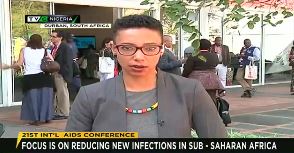TVC E. Sub-Saharan Africa has the most serious HIV and AIDS epidemic in the world. In 2013, an estimated 24.7 million
people were living with HIV, accounting for 71% of the global total. In the same year, there were an estimated 1.5 million new HIV infections and 1.1 million AIDS-related deaths.1
Now the focus is on reducing the spread of HIV/AIDS in the Sub- Sahara regions.
HIV prevalence for the region is 4.7% but varies greatly between regions within sub-Saharan Africa as well as individual countries. For example, Southern Africa is the worst affected region and is widely regarded as the ‘epicentre’ of the global HIV epidemic. Swaziland has the highest HIV prevalence of any country worldwide (27.4%) while South Africa has the largest epidemic of any country – 5.9 million people are living with HIV. By comparison, HIV prevalence in West and East Africa is low to moderate ranging from 0.5% in Senegal to 6% inKenya.2
While many countries have large, generalised epidemics, research has shown how groups such as young women and men who have sex with men are particularly at risk of HIV.
Young women
While the vast majority of new HIV infections in sub-Saharan Africa occur in adults over the age of 25, HIV disproportionately affects young women. More than 4 in 10 new infections among women are in young women aged 15-24. 15-19 year olds are particularly at risk equating to higher HIV prevalence rates when they are older.3
For example, in Mozambique, HIV prevalence is 7% among 15-19 year olds but rises to 15% for 25 years olds. Likewise, in Lesotho, HIV prevalence rises from 4% among 15-19 year olds to 24% among 20-24 year olds.4
A review of 45 studies across sub-Saharan Africa found that relationships between young women and older men are common and associated with unsafe sexual behaviour and low condom use, which heightens their risk of HIV infection.5
Children
In July 2011, UNAIDS developed a Global Plan to eliminate new HIV infections among children by 2015 and keep their mothers alive, and identified 21 priority countries in sub-Saharan Africa.6
Since 2009, there has been a 43% decline in new HIV infections among children in the Global Plan priority countries, from 350,000 to 200,000 in 2013. However, declines vary greatly between countries.7
For example, in this period, new HIV infections among children in Malawi declined by 67% and by over 50% inBotswana, Ethiopia, Ghana, Mozambique, Namibia, South Africa and Zimbabwe. By contrast, Nigeria only achieved a 19% fall and accounted for a quarter of new HIV infections among children in Global Plan priority countries in 2013 (51,000 cases).8
Sex workers
Sex workers are also at particularly high risk of HIV in sub-Saharan Africa. Average HIV prevalence among this group is an estimated 20% compared to just 3.9% globally. In fact, 17 of the top 18 countries where HIV prevalence exceeds 20% among sex workers, are in sub-Saharan Africa.9
In 2013, five of the six sub-Saharan African countries that reported prevalence rates among both female and male sex workers found female sex workers were more affected. However, HIV prevalence among male sex workers was still high (13%).10
This is despite high levels of reported condom use where 86% of sex workers used one the last time they had sex, while 78% of female sex workers reported receiving a free condom. However, condom distribution often varies greatly within countries.11
Men who have sex with men
While data on men who have sex with men (MSM) is very limited for sub-Saharan Africa, HIV prevalence is believed to be very high. According to national AIDS response progress reports, HIV prevalence among this group is 15% across West and Central Africa and 14% across East and Southern Africa.12
However, there are great disparities between countries. For example, HIV prevalence among MSM in nine countries was reported at under 1%. By contrast, up to 54% of MSM in Mauritania and 57% of MSM in Guinea are thought to be living with HIV.13


















